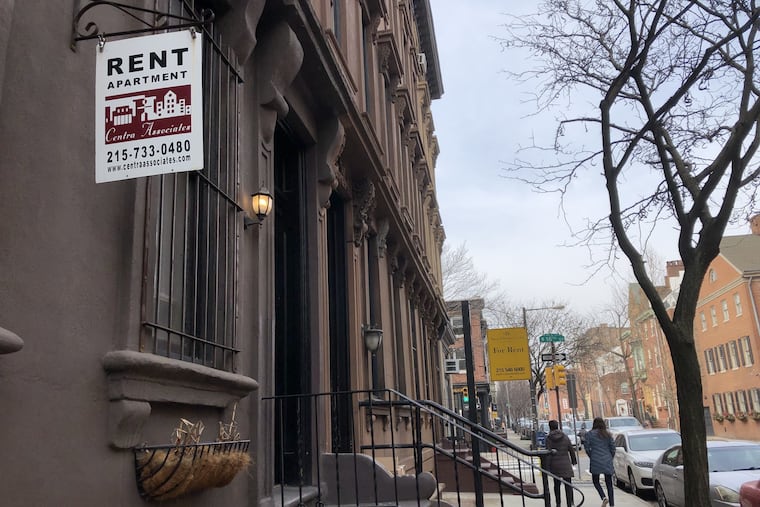Unemployed renters ride the uncertain tide of fluctuating aid
Renters are more likely than homeowners to work in industries the pandemic has hit hardest. So, as a whole, they have been especially vulnerable to the ups and downs of unemployment benefits.

For people who lost work during the pandemic, life is one big uncertainty. Some jobless Philadelphians have gone from receiving hundreds of dollars a week in unemployment benefits to less than $50 without understanding why, said Andrew Lee, an organizer with the nonprofit Philadelphia Unemployment Project.
“You can imagine how stressful it is for households with unemployed family members trying to budget for necessities like rent or heat or food,” when they don’t know how much money will be coming in from week to week, he said.
Renters are more likely than homeowners to work in industries that the pandemic has hit hardest. So, as a whole, they have been especially vulnerable to variations in unemployment benefits, their primary income. One source of that variation has been the ups and downs in supplemental payments from the federal government. The share of people’s income that has had to go toward housing — at the expense of other essentials — also has fluctuated with these payments.
When the federal government added $600 in weekly payments to states’ unemployment benefits early in the pandemic, a typical unemployed renter in the Philadelphia metropolitan area was spending roughly 29% of that income on rent, according to a report Zillow released this month. That’s just under the 30% threshold at which a household is considered rent burdened. High rent burdens in communities are associated with higher rates of homelessness.
When the $600 federal unemployment payments stopped at the end of July and $300 payments replaced them, the rent burden on Philadelphia-area households increased. Unemployed renters in the region were spending roughly 43% of that income on rent.
In the fall, federal payments stopped altogether and the share of income that unemployed tenants spent on rent jumped to about 79%. The $300 federal payments picked back up again this winter.
“This roller coaster ride is a clear demonstration of just how much of a difference even modest amounts of federal assistance can mean to struggling renters,” Chris Glynn, a senior economist at Zillow, wrote in his report.
“And there’s another looming cliff coming in March,” Glynn said in an interview, referring to the scheduled end of the $300 supplemental federal unemployment benefits. “So the ride may not be over yet.”
» READ MORE: How low-income people are spending their $600 pandemic stimulus payments
President-elect Joe Biden’s coronavirus relief legislation is expected to extend supplemental federal unemployment benefits, which also can help renters reduce the debt they owe their landlords. But some residents in the region who qualify for unemployment benefits have been waiting months for payments.
Jonette Prescott of West Philadelphia was a successful door-to-door salesperson, enticing people to try solar panels or otherwise save money on their electric bills. Then, in April, she lost work because of the pandemic. Prescott, 50, was able to go back to work for a couple months during the summer before she was out of a job again. She has continued to fight for benefits. Over the last nine months, she has received $1,100, she said.
Prescott has been staying in a room of a house owned by a family member’s acquaintance. She gives the homeowner what money she can but hasn’t been able to afford regular payments without a job or unemployment income. She is grateful the owner is letting her stay without charging her. But it’s not the home she envisioned for herself before the pandemic, when she was living in a shelter and saving money to be able to rent a home of her own.
“I didn’t want to rent somewhere and end up evicted because I couldn’t pay the rent,” she said.
» READ MORE: Jobless workers have spent months waiting to get paid Pandemic Unemployment Assistance benefits: ‘It’s a nightmare’
Lee, of the Philadelphia Unemployment Project, which advocates for jobs, housing protections and benefits for jobless residents, said one woman’s unemployment benefits cover only 70% of her rent. She picks up hairdressing jobs when she can for some extra income.
“It is especially egregious that benefits that people have paid their way into are not sufficient to cover normal living expenses,” Lee said.
In Philadelphia, the median rent for apartments is $973 for one bedroom and $1,127 for two, according to an Apartment List report released this month. The federal government’s boost to unemployment benefits gives households more room to pay for food, utilities, and other expenses. But since unemployment because of the pandemic is the main reason renters can’t pay their rent, overcoming the pandemic and bringing back jobs is critical.
The current employment landscape, said Glynn at Zillow, “creates a really nasty housing vulnerability problem for many households, where our most vulnerable households are the ones that have been disproportionately impacted.”
Black and Latino households are more likely than white households to both rent their home and to have lost work because of the pandemic.
The Philadelphia Inquirer is one of more than 20 news organizations producing Broke in Philly, a collaborative reporting project on solutions to poverty and the city’s push toward economic justice. See all of our reporting at brokeinphilly.org.